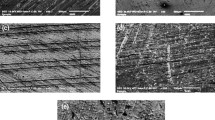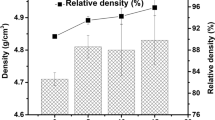Abstract
Wettability of liquid A359 alloy on SiC particles under molten salt NaCl-KCl-NaF is found at 180 deg, meaning that SiC particles prefer the molten salt phase against the Al phase or the Al/molten salt interface. Thus, this molten salt can be used for recycling, i.e., to separate the phases in the SiC reinforced Al matrix composites. If the separation process is interrupted, Al droplets (submillimeter solidified powder) can be produced, stabilized/surrounded by a monolayer of shielding SiC particles.






Similar content being viewed by others
References
N. Chawla and K.K. Chawla: JOM, 2006, Nov., pp. 67–70.
T. Fan, D. Zhang, G. Yang, T. Shibayangi, M. Naka, T. Sakata, and H. Mori: Composites A, 2003, vol. 34, pp. 291–99.
G. Yang, T. Fan, and D. Zhang: Mater. Lett., 2004, vol. 58, pp. 1546–52.
N. Nicom and H. Nomura: Mater. Sci. Eng. A, 2006, vol. 441, pp. 97–105.
K. Takahashi and S. Taniguchi: ISIJ Int., 2003, vol. 43, pp. 820–27.
V. Kamavaram, D. Mantha, and R.G. Reddy: Electrochim. Acta, 2005, vol. 50, pp. 3286–95.
Y. Nishida, N. Izawa, and Y. Kuramasu: Metall. Mater. Trans. A, 1999, vol. 30A, pp. 839–44.
K.R. Ravi, B.C. Pai, R.M. Pillai, and M. Chakraborty: Proc. Int. Symp. Research Studies in Materials Science and Engineering, Chennai, India, 2004, pp. 1–11.
H. Sano, S. Kato, T. Motomura, and T. Fujisawa: Mater. Trans., 2005, vol. 46, pp. 3067–72.
K.R. Ravi, R.M. Pillai, B.C. Pai, and M. Chakraborty: Bull. Mater. Sci., 2007, vol. 30, pp. 393–98.
I. Budai and G. Kaptay: J. Mater. Sci., 2010, vol. 45, pp. 2090–98.
A.R. Kennedy and A.E. Karantzalis: Mater. Sci. Eng. A, 1999, vol. 264, pp. 122–29.
P. Baumli, J. Sytchev, and G. Kaptay: J. Mater. Sci., 2010, vol. 45, pp. 5177–90.
I. Budai and G. Kaptay: Metall. Mater. Trans. A, 2009, vol. 40A, pp. 1524–28.
B. Masson and M.M. Taghei: Mater. Trans. JIM, 1989, vol. 30, pp. 411–22.
R.R. Roy and Y. Sahai: Mater. Trans. JIM, 1997, vol. 38, pp. 995–1003.
R.R. Roy and Y. Sahai: Mater. Trans. JIM, 1997, vol. 38, pp. 571–74.
R. Wu, B. Sun, H. Ni, D. Shu, H. Chen, and F. Li: J. Mater. Sci., 2004, vol. 39, pp. 6867–69.
G. Kaptay: J. Mater. Sci., 2005, vol. 40, pp. 2125–31.
N. Eustathopoulos, M.G. Nicholas, and B. Drevet: Wettability at High Temperatures, Pergamon, New York, NY, 1999, pp. 1–53.
G.J. Janz, G.R. Lakshminarayanan, R.P.T. Tomkins, and J. Wong: Molten Slats: Volume 2, Section 2. Surface Tension Data, NSRDS-NBS 28, Washington, DC, 1969, pp. 49–111.
B.J. Keene: Int. Mater. Rev., 1993, vol. 38, pp. 157–92.
J. Goicoechea, C. Garcia-Cordovilla, E. Louis, and A. Pamies: J. Mater. Sci., 1992, vol. 27, pp. 5247–52.
J.P. Anson, R.A.L. Drew, and J.E. Gruzelski: Metall. Mater. Trans. B, 1999, vol. 30B, pp. 1027–32.
L. Martin-Garin, A. Dinet, and J.M. Hicter: J. Mater. Sci., 1979, vol. 14, pp. 2366–72.
A. Silny and T.A. Utigard: J. Chem. Eng. Data, 1996, vol. 41, pp. 1340–45.
R.R. Roy and Y. Sahai: Mater. Trans. JIM, 1997, vol. 38, pp. 546–52.
G. Kaptay and E. Báder: Trans. JWRI, 2001, vol. 30, Special Issue, pp. 55–60.
L. Goumiri and J.C. Joud: Acta Metall., 1982, vol. 30, pp. 1397–1405.
C. Garcia-Cordovilla, E. Louis, and A. Pamies: J. Mater. Sci., 1986, vol. 21, pp. 2787–92.
G. Kaptay: Mater. Sci. Forum, 1991, vol. 77, pp. 315–30.
V. Sarou-Kanian, F. Millot, and J.C. Rifflet: Int. J. Thermophys., 2003, vol. 24, pp. 277–86.
G. Kaptay: Mater. Sci. Eng. A, 2008, vol. 495, pp. 19–26.
J. Sytchev, C. Mekler, and J. Szabó, BAY-NANO, are acknowledged for their help. A. Rácz, Refmon, is acknowledged for the crucibles. Financing by the AFT project of NKTH, Hungary, is acknowledged (P. Bárczy and T. Bárczy, Admatis Ltd., project leaders) and by OTKA-NKTH CK 80255 project, Hungary.
Author information
Authors and Affiliations
Corresponding author
Additional information
Manuscript submitted July 17, 2010.
Appendix: A Theoretical Analysis of the Measured Contact Angle
Appendix: A Theoretical Analysis of the Measured Contact Angle
The contact angle of liquid metal (m) on a solid substrate (s) in the environment of a flux (f), as shown in Figure 1, can be written in accordance with the Young equation as
where σ sf , σ sm , and σ mf are solid/flux, solid/liquid metal, and liquid metal/flux interfacial energies, respectively (all with the unit of J/m2). Equation [1] can be rewritten into a more convenient form:[13,20]
where σ mg and σ fg are surface tensions of the liquid metal and that of the molten flux, respectively, while W sm and W sf are adhesion energies in the solid/liquid metal and in the solid/molten flux couples (all with the unit of J/m2). As our experiments were conducted at 1053 K (780 °C), all values of Eq. [2] will be estimated at this temperature.
The surface tension of the pure salt components have the following values: 100 mJ/m2 (KCl), 115 mJ/m2 (NaCl), and 203 mJ/m2 (NaF).[21] Obviously, KCl is the surface-active component in the molten flux. As its content in the flux is high (close to 50 mol pct), the surface tension of the molten salt is expected to be close to the surface tension of KCl. Thus, it is estimated to be in the following interval: σ fg = 105 ± 5 mJ/m2.
The surface tension of the main pure liquid metal components (Table I) has the following values: 850 mJ/m2 (Al), 866 mJ/m2 (Si), and 543 mJ/m2 (Mg).[22] Although Mg is a surface-active component, it is present in the alloy in a small quantity and it is heavily complexed by both Al and Si. Therefore, it will not have a large influence on the surface tension of the alloy. Nevertheless, it is expected that the surface tension of the alloy will be somewhat smaller compared to that of pure Al. Thus, the surface tension of the alloy is expected to be in the following interval: σ mg = 840 ± 30 mJ/m2. This estimated value is in accordance with experimental data for the ternary Al-Si-Mg alloy.[23,24]
The interfacial energy between pure liquid Al and the molten flux studied in this system is measured to be about σ mg = 450 ± 30 mJ/m2.[25–27]
The exact values of the adhesion energies are difficult to estimate. One should compare the adhesion energies in liquid metal/covalent solid and molten flux/covalent solid systems. The adhesion energy is expected to be due to weak van der Waals forces, in the interval between 100 and 300 mJ/m2.[20,28] In the metal/covalent systems, the adhesion is due to the induced dipole/induced dipole (London) interaction, being the weakest possible interaction. A somewhat stronger interaction is expected in the molten flux/covalent system, due to the role of the polarizing ions in the molten salt. That is why the difference in adhesion energies is estimated as W sm – W sf = –200 ± 100 mJ/m2.[28]
Substituting the preceding values into Eq. [3], the following value for the cosine of the contact angle is obtained:
From Eq. [3], one can see that Θ s/m/f = 180 deg. It should be mentioned that when the surface of liquid Al is free of oxide, it is expected to have a somewhat higher value of σ mg .[29–33] In the preceding analysis, the segregation of Si and Mg to the liquid alloy/molten salt interface was neglected as well. If such takes place, it can only reduce the value of σ mf . Thus, both of these effects (possible increase of σ mg and possible decrease of σ mf ) would only lead to a more negative value of cosΘ s/m/f ; i.e., these effects will not change the main conclusion of this Appendix (Θ s/m/f = 180 deg). This theoretical prediction is in full accordance with our experimental results given in the main text of this article and with some earlier experimental data on similar (not identical) systems.[7–10]
Rights and permissions
About this article
Cite this article
Madarasz, D., Budai, I. & Kaptay, G. Fabrication of SiC-Particles-Shielded Al Spheres upon Recycling Al/SiC Composites. Metall Mater Trans A 42, 1439–1443 (2011). https://doi.org/10.1007/s11661-011-0691-2
Published:
Issue Date:
DOI: https://doi.org/10.1007/s11661-011-0691-2




